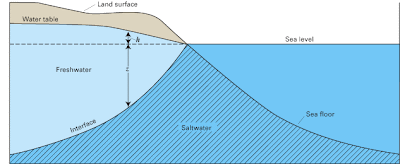In every costal area there is a risk of seawater intrusion. Seawater intrusion is when saline water, defined as water with a concentration of dissolved salts of more than 1000 mg/L, migrates into the groundwater system. When the fresh water in aquifers gets replaced by saline water the wells becomes useless for drinking and agriculture. The intrusion of salt water can also affect habitats and ecosystems.
Seawater intrusion can occur naturally, usually together with storm surges, the storm presses salt water into the aquifers. But the most common cause of seawater intrusion is overexploitation of the groundwater by humans.
In costal regions there is always an intrusion of saline water into the aquifers as can be seen in fig. 1
How far the intrusion goes inland depends on the flow of the groundwater. The Ghyben-Herzberg relation describes the ralation between the hight of the groundwater above the sea level and the depth under it. Simplified it is:
z = 40h. This means we can detect seawater intrusion in costal regions by measuring the hight of the groundwater.
|
|
Seawater intrusion due to pumping
|
The most common source for seawater intrusion is when the pressure in the aquifers is lowered, this causes an up dwelling of saline water into the aquifers.
As you can see from fig. 2, the usage of groundwater causes a depression in the water level and a seawater intrusion. If this continues the well will eventually be filled by saline water and you have to dig a new one.
If the replenishment of groundwater is slow and/or the usage of it is very high seawater intrusion can spread far inland. This has already happened in Florida, where large parts of southern Florida has ground water with a salt concentration of more then 1000 mg/L



